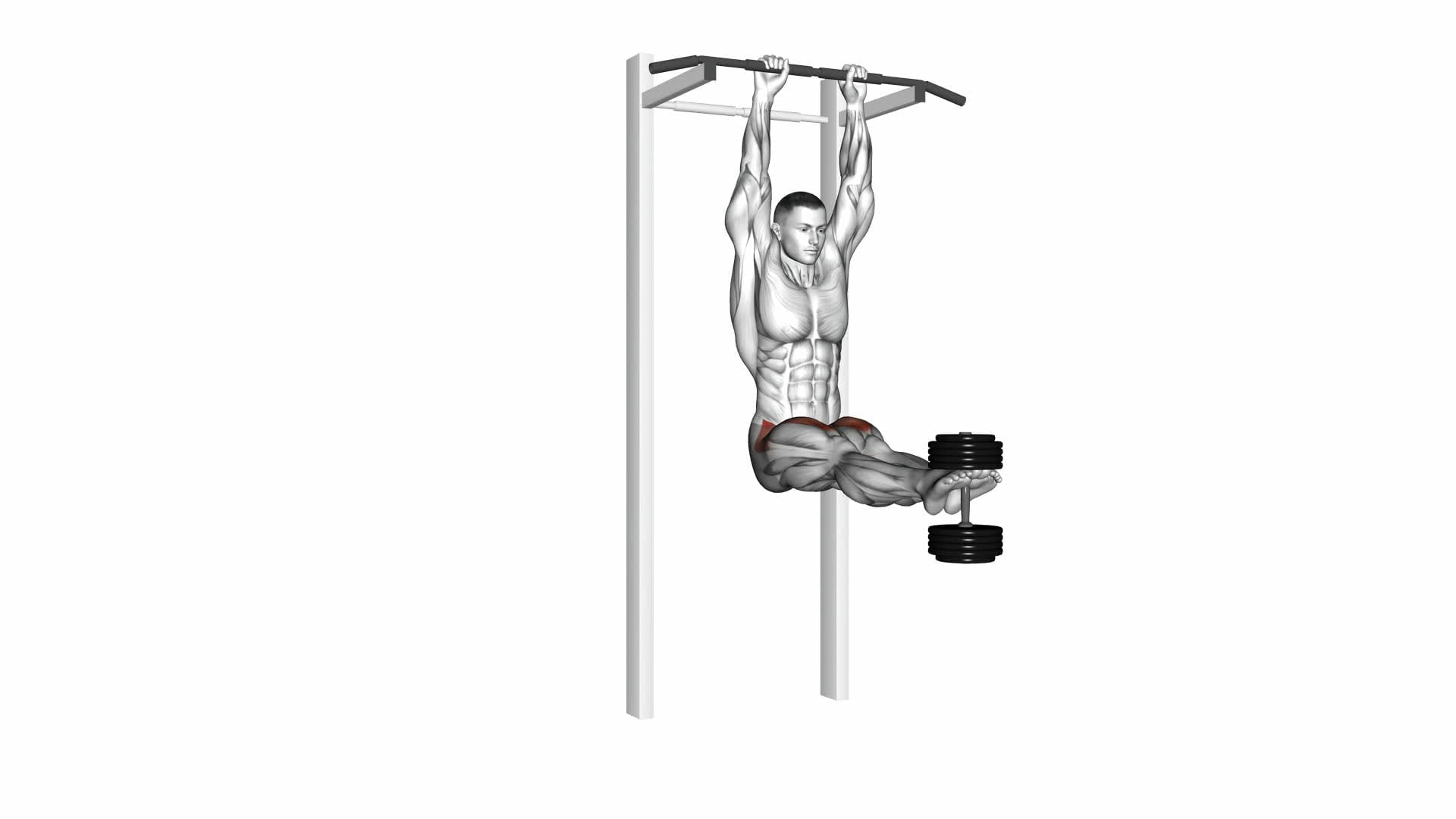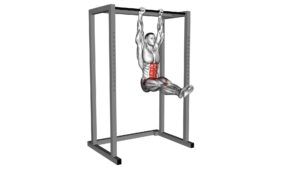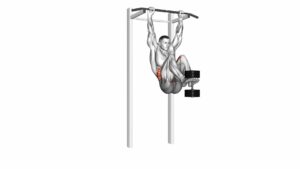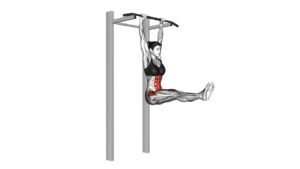Weighted Hanging Straight Leg Raise – Video Exercise Guide & Tips

Are you looking to strengthen your core and lower body? Discover the benefits of the weighted hanging straight leg raise!
Watch This Exercise Video
This exercise targets your abs, hip flexors, and quads, helping you build a strong and toned physique.
With just a few simple modifications, you can increase the difficulty and intensity to challenge yourself even more.
Get ready to take your fitness to the next level with this informative video exercise guide and helpful tips.
Let's get started!
Key Takeaways
- Targets abs, hip flexors, and quads
- Builds a strong and toned physique
- Increases core strength
- Helps prevent lower back pain and reduce the risk of injuries
Benefits of Weighted Hanging Straight Leg Raise
Get ready to discover the benefits of weighted hanging straight leg raises! This challenging exercise isn't only a great way to build strength in your core muscles but also offers a range of other benefits. One of the main advantages of weighted hanging straight leg raises is their effectiveness in targeting the entire core, including the lower abs, hip flexors, and lower back. By adding weights, you increase the resistance, making the exercise more challenging and helping to develop greater core strength.
Having a strong core has numerous benefits beyond just aesthetics. It improves posture, stability, and overall body control. A strong core also helps to prevent lower back pain and reduces the risk of injuries during other activities or sports. Weighted hanging straight leg raises are an excellent exercise to incorporate into your routine if you're looking to strengthen your core and reap these benefits.
If you're unable to perform weighted hanging straight leg raises, there are alternatives that can still help you develop core strength. Some alternatives include hanging knee raises, lying leg raises, and planks. These exercises target the same muscles and can be modified to suit your fitness level. Remember, it's essential to consult with a fitness professional before starting any new exercise program to ensure proper form and prevent injuries.
Equipment Needed for Weighted Hanging Straight Leg Raise
To perform weighted hanging straight leg raises, you'll need some specific equipment. Here are some suggestions for the equipment you'll need:
- Weighted Vest: A weighted vest is a great option for adding resistance to your leg raises. It allows you to easily adjust the weight and keep your hands free during the exercise.
- Ankle Weights: Ankle weights are another option for adding resistance to your leg raises. They can be strapped around your ankles to increase the difficulty of the exercise.
- Dip Belt: A dip belt is a belt with a chain or strap that allows you to attach weight plates. It can be worn around your waist to add weight to your leg raises.
- Weight Plates: Weight plates are used in conjunction with a dip belt. They come in different sizes and can be easily added or removed to adjust the weight.
- Resistance Bands: Resistance bands can be used to provide assistance or resistance during the exercise. They can be attached to a pull-up bar and looped around your feet to add resistance.
When choosing the right weight for weighted hanging straight leg raises, it's important to start with a weight that challenges you but allows you to maintain proper form. Gradually increase the weight as you become stronger. Remember to listen to your body and adjust the weight accordingly to avoid injury.
Proper Technique for Weighted Hanging Straight Leg Raise
To execute the weighted hanging straight leg raise properly, engage your core muscles and maintain a controlled movement throughout the exercise. Start by hanging from a pull-up bar with your arms fully extended and your legs straight. Grip the bar with your palms facing away from you, shoulder-width apart. Engage your core by pulling your belly button towards your spine and keeping your back straight.
As you raise your legs, focus on using your lower abdominal muscles to lift them up towards the ceiling. Avoid swinging or using momentum to lift your legs. Keep the movement slow and controlled to fully engage your core.
Common mistakes to avoid include using your hip flexors to lift your legs instead of your core muscles. This can lead to lower back strain and less effective targeting of the abdominals. Another mistake isn't maintaining proper form throughout the exercise. If you find it difficult to control the movement, try reducing the weight or using a regression exercise such as bent knee raises.
To progress the exercise, you can increase the weight gradually or try performing the exercise with straight legs and ankle weights. Remember, proper technique is crucial for getting the most out of the weighted hanging straight leg raise and avoiding injury. So, focus on engaging your core, maintaining control, and avoiding common mistakes.
Tips for Increasing Difficulty and Intensity
To increase the difficulty and intensity of the weighted hanging straight leg raise, you can incorporate various techniques and modifications. Here are some tips to help you challenge yourself and take your workout to the next level:
- Increase resistance: Gradually add weight to your ankles using ankle weights or a weighted vest. This will make your muscles work harder and increase the intensity of the exercise.
- Use a stability ball: Place a stability ball between your legs and squeeze it as you raise your legs. This will engage your inner thighs and core muscles, making the exercise more challenging.
- Slow down the movement: Perform the leg raise slowly and with control. This will place more emphasis on your abs and make the exercise more intense.
- Try single leg raises: Lift one leg at a time while keeping the other leg extended. This variation will require more stability and strength from your core muscles.
- Incorporate hanging knee raises: Once you have mastered the straight leg raise, progress to hanging knee raises. This exercise targets the lower abs and is more challenging.
By implementing these advanced modifications, you can continue to challenge your muscles and improve your strength and endurance.
Now, let's explore modifications and variations for different fitness levels.
Modifications and Variations for Different Fitness Levels
Adjustments and options are available to cater to individuals of different fitness levels when performing the weighted hanging straight leg raise. If you're a beginner, scaling options can help you gradually build strength and improve your form.
One option is to start by performing the exercise without any additional weight. This allows you to focus on mastering the movement and developing core strength. As you become more comfortable, you can gradually increase the weight by using ankle weights or holding a dumbbell between your feet.
For those who are more experienced and looking for advanced progressions, there are several options to challenge yourself further. One option is to increase the weight by using a weighted vest or holding a heavier dumbbell between your feet. This will increase the resistance and make the exercise more challenging for your core muscles.
Another progression is to perform the exercise with straight arms instead of bent elbows. This engages your upper body muscles more, adding an extra level of difficulty.
Remember, regardless of your fitness level, it's important to maintain proper form and listen to your body. If an exercise feels too challenging or causes pain, it's best to modify or seek guidance from a fitness professional.
Take your time, progress at your own pace, and enjoy the benefits of the weighted hanging straight leg raise.
Frequently Asked Questions
How Many Sets and Reps Should I Do for Weighted Hanging Straight Leg Raises?
To determine the number of sets and reps for weighted hanging straight leg raises, consider your fitness level and goals.
Start with 3 sets of 8-12 reps and gradually increase the weight and intensity as you progress.
It's important to maintain proper form throughout the exercise to avoid common mistakes like swinging or using momentum.
Focus on engaging your core and using controlled movements to maximize the benefits of this challenging exercise.
Can I Do Weighted Hanging Straight Leg Raises if I Have Lower Back Pain?
If you have lower back pain, it's important to be cautious when doing weighted hanging straight leg raises. These exercises can put strain on your lower back, potentially worsening your pain.
It would be wise to consult with a healthcare professional or a certified trainer for modifications that can be made to the exercise to avoid aggravating your condition.
There are other exercises that can target your abs and lower body without putting excessive stress on your lower back.
What Muscles Does the Weighted Hanging Straight Leg Raise Target?
The weighted hanging straight leg raise primarily targets your abdominal muscles, specifically the rectus abdominis. It also engages the hip flexors and the muscles in your lower back.
By adding weight to the exercise, you increase the intensity and challenge your core even more.
To get the most out of this exercise, remember to maintain proper form, keeping your legs straight and using your abs to lift them up towards the ceiling.
Can I Use Ankle Weights Instead of a Dumbbell for Added Resistance?
Yes, you can definitely use ankle weights instead of a dumbbell for added resistance during the weighted hanging straight leg raise. Ankle weights offer a convenient way to increase the challenge of the exercise without the need for additional equipment.
Is It Necessary to Have a Spotter or Can I Do Weighted Hanging Straight Leg Raises on My Own?
When it comes to weighted hanging straight leg raises, you might be wondering if you need a spotter or if you can do it on your own. Well, the good news is that you can do this exercise solo! However, having a spotter can be beneficial, especially if you're using heavy weights. They can help ensure proper form and prevent any accidents.
If you choose to go solo, make sure to focus on your technique and start with lighter weights before progressing to heavier ones.
Conclusion
Incorporating the weighted hanging straight leg raise into your exercise routine can offer numerous benefits. This exercise is particularly effective for strengthening your core, improving balance, and targeting your lower abdominal muscles.
To perform this exercise effectively, you will need the right equipment and proper technique. Make sure you have access to a pull-up bar or a stable structure that can support your body weight.
To increase the difficulty and intensity of the exercise, you can try adding more weight to your legs or perform slower and controlled movements. This will engage your muscles even more and help you build strength.
It's also worth noting that there are modifications and variations available for different fitness levels. If you're a beginner, you can start by performing the exercise without any additional weight or by bending your knees instead of keeping your legs straight.
So, get ready to challenge yourself and elevate your fitness journey with this powerful exercise. Incorporate the weighted hanging straight leg raise into your routine and enjoy the benefits it brings to your core strength, balance, and lower abdominal muscles.

Author
Years ago, the spark of my life’s passion ignited in my mind the moment I stepped into the local gym for the first time. The inaugural bead of perspiration, the initial endeavor, the very first surge of endorphins, and a sense of pride that washed over me post-workout marked the beginning of my deep-seated interest in strength sports, fitness, and sports nutrition. This very curiosity blossomed rapidly into a profound fascination, propelling me to earn a Master’s degree in Physical Education from the Academy of Physical Education in Krakow, followed by a Sports Manager diploma from the Jagiellonian University. My journey of growth led me to gain more specialized qualifications, such as being a certified personal trainer with a focus on sports dietetics, a lifeguard, and an instructor for wellness and corrective gymnastics. Theoretical knowledge paired seamlessly with practical experience, reinforcing my belief that the transformation of individuals under my guidance was also a reflection of my personal growth. This belief holds true even today. Each day, I strive to push the boundaries and explore new realms. These realms gently elevate me to greater heights. The unique combination of passion for my field and the continuous quest for growth fuels my drive to break new ground.







